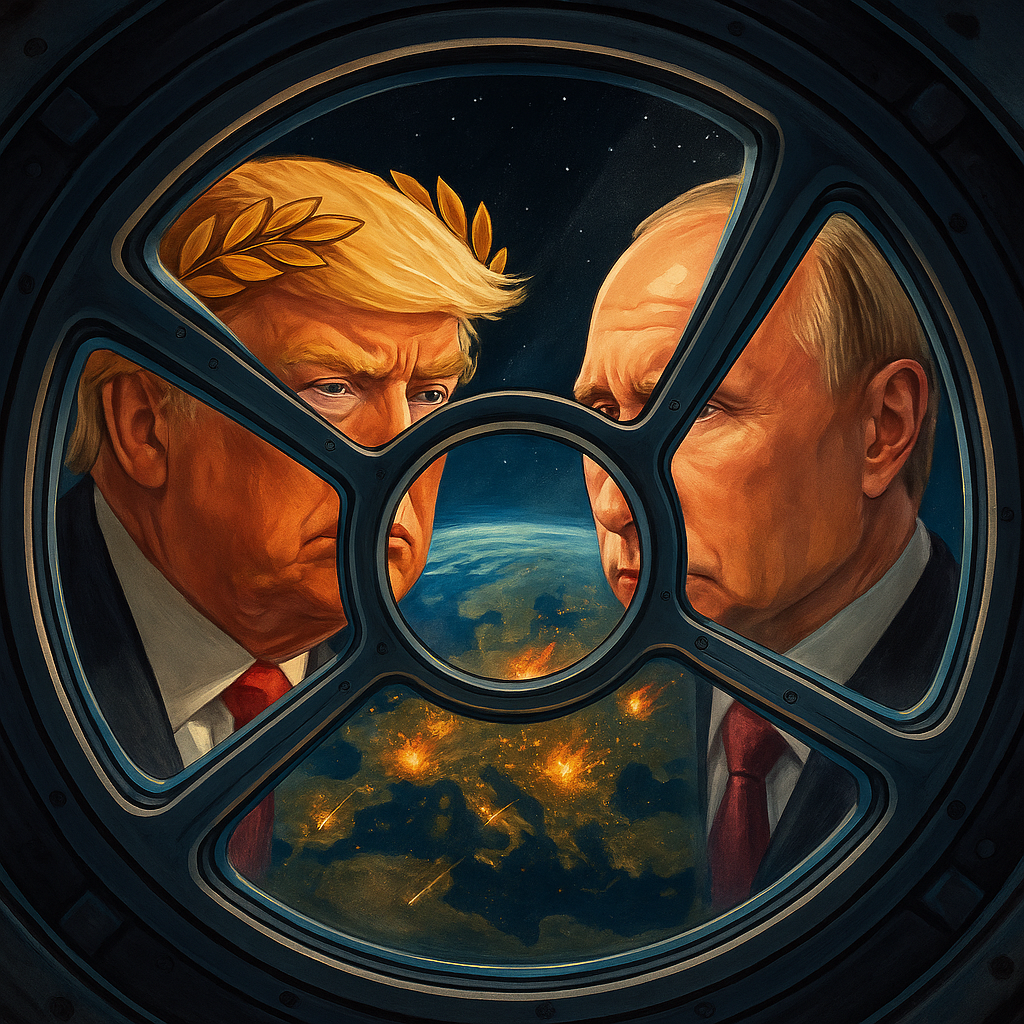Putin’s Imperial Strategy and Europe’s Vulnerable Flank
Why Europe Must Build Credible Collective Deterrence Now—Before It Becomes Prey to a Determined Autocrat
Introduction
Europe stands on the edge—not of a sudden event but of silent cracks. The global climate crisis is destabilizing infrastructure, supply chains, and societies—and an authoritarian state like Russia is likely to exploit exactly those weaknesses. While many in Europe still believe in diplomacy and détente, a hybrid attack scenario is already unfolding—based on our systemic complacency.
The Core of Putin’s Imperial Mindset
Vladimir Putin is not a classical nationalist—he is an old-school imperialist, shaped by the KGB worldview. His identity and mindset formed within the Soviet intelligence system, in a world of control, maintenance of power, and geopolitical dominance. For him, the collapse of the Soviet Union was not just a political but a deeply personal humiliation. Today’s Russia, in his eyes, must rebuild a historical empire, regaining control over former Soviet territories—and even beyond.
Putin grew up in post-war Leningrad—in poverty, surrounded by violence, hierarchy, and glorification of the Soviet victory over Hitler. His later service as a KGB officer in East Germany instilled a worldview where loyalty, control, and power retention reign supreme.
His vision is not short-term. He thinks in decades. He exploits Western democratic inertia and deliberative culture. While we debate, he acts. While we draft strategy papers, he builds real power structures.
The Targeted “Depopulation” of Russia’s East
Russia is not homogeneous. Many regions formally part of the federation were historically independent cultures and ethnicities—Buryatia, Dagestan, Tuva, Chechnya, Yakutia, Bashkortostan, to name a few. These regions have been militarily conquered, culturally suppressed, and economically exploited over centuries—first by the tsarist empire, then the Soviet Union, and later the Russian Federation.
Today, a large share of frontline soldiers in the war on Ukraine are drawn from these regions. They are disproportionately conscripted, often under coercion, ill-equipped, and untrained. They serve as cannon fodder; their loss alleviates long-term demographic pressure back home—they no longer require social services, pose no political threat, and reduce instability in Russia’s ethnic heartland.
Thus, this war is not only an imperial endeavor abroad—it’s also an internal ethnic-engineering operation. In Putin’s worldview, stabilizing ethnic Russians and weakening restive Eastern regions is both geopolitically and domestically strategic.
Why Germany, Poland, and the Baltics Are Valuable Targets
Many argue: “Why would Putin target Germany? Russia has immense natural resources.” This view misses the real logic of imperial conflict.
- Know-how and Human CapitalGermany, Poland, and the Baltic states have top-tier education systems, technically skilled workforces, and robust economies. Technological and organizational expertise far surpasses most of Russia. For Putin, this knowledge is more valuable than any natural resource.
- Industrial Production BaseGermany is Europe’s industrial engine: machinery, chemicals, medical tech, logistics, software. Controlling these would be a long-term strategic gain—both weakening the EU and granting access to technologies hard to develop within Russia.
- Geopolitical LeverageControlling Germany, Poland, or the Baltics means dominance over critical transport routes, ports, pipelines, internet hubs, and supply chains in Europe. It would also deal a psychological blow to NATO if its strongest member becomes militarily or economically compromised.
- Symbolic PowerAn attack on Germany wouldn’t automatically draw U.S. forces—but it would be a profound blow to the Western alliance. It would demonstrate that Putin can project power without crossing the nuclear threshold—and without triggering immediate NATO military response.
- Baltics and Poland—Strategic and IdeologicalThe Baltics were once Soviet territory; Poland has firmly aligned with NATO and the EU. For Putin, these nations represent ideological rejection and geopolitical loss. Their subjugation would serve as both prestige and leverage over Europe.
The Quiet Weakening Through Climate Crisis and System Overload
Climate disasters, wildfires, water shortages, power blackouts—these increasingly destabilizing forces highlight how susceptible modern digital infrastructure is to failure. Germany and other European nations rely on systems that fail quickly during crises. By contrast, Russia—paradoxically—has more resilient, less digitized infrastructures in some areas. What we call “backwardness” can become strength in crisis: robust, autonomous systems, less dependency on digital control, and stronger state oversight.
Putin’s Maritime Shadow Fleet: The Underestimated Threat at Sea
While Europe focuses on tanks, missiles, and infantry, Russia methodically builds a maritime deterrent that exceeds conventional naval warfare. This involves not only warships but also a hybrid fleet—military, commercial, and covert vessels—in strategic waters.
The Shadow Fleet: Economic and Strategic Tool
Since sanctions began, Russia has operated a so-called “shadow fleet”—tankers and cargo ships with hidden ownership, ghost flags, and deactivated transponders. These vessels evade Western sanctions, move oil through international waters, and serve economic, intelligence, and logistical roles. They discreetly transport supplies, fuel, parts, even weapons—under the radar and below escalation thresholds.
The Baltic Sea: Russia’s Strategic Chokepoint
With Sweden and Finland joining NATO, the Baltic Sea has become a strategic bottleneck for Russia. Its militarized exclave Kaliningrad, surrounded by NATO territory, becomes a forward bastion. Moscow has escalated submarine activity, electronic warfare, and provocations at sea. Sabotage of undersea cables and pipelines (e.g., Nord Stream) underscores the region’s vulnerability.
In a crisis, Russia could exercise covert maritime control—blocking shipping, sabotaging ports, or disrupting data cables. Such actions are hard to trace or counter collectively—making the Baltic ripe for hybrid warfare.
The Bering Sea: A Silent Forward Base
In the Far East, Russia expands its presence in the Bering Sea near Alaska—through joint patrols with China, large-scale exercises, and upgraded naval bases. This region, once a remote backwater, is opening due to climate change. Russia aims to control new Arctic shipping lanes to Asia—far from Western oversight.
This has global and European implications: a Russian-dominated Arctic could reroute trade, enable economic blackmail, and project geopolitical power—quietly but effectively.
Maritime Weakness in Europe
European nations have neglected naval power. Beyond fewer ships and personnel, there’s no coherent maritime strategic doctrine. As Russia pushes a mindset of asymmetric naval warfare, the EU lacks a unified maritime defense framework. NATO members along the North and Baltic Sea are left exposed—economically, infrastructurally, psychologically.
The Northern Sea Route (NSR): Militarized Corridor
Climate change opens once icebound routes—like the Northern Sea Route along Russia’s northern coast from the Barents Sea to the Bering Strait. This corridor can cut shipping distances drastically (up to 40% shorter than via the Suez Canal). But this isn’t a peaceful shortcut—it’s a Kremlin-regulated choke point.
Russia asserts control: permits, fees, icebreakers, and its military presence—reactivated bases, radar, missiles, and nuclear submarines. The Northern Sea Route is militarized, patrolled, and serves strategic interests—not global trade.
China has also increased presence—through research missions and discreet naval cooperation. Civilian trade vessels avoid the NSR due to security, limited rescue infrastructure, and political uncertainties—only Russian vessels, often military-protected, traverse it.
This Arctic militarization presents Europe with a geostrategic defeat: the EU lacks maritime infrastructure, defensive presence, or investments in the Arctic—despite its proximity through Norway and Iceland.
The Dangerous Illusion of “Time Until 2035”
Many EU-and-state-level security strategies aim for 2035 as a benchmark for enhanced defense posture. But this timeline is a dangerous mirage.
We do not have a decade to prepare. We’ve already lost two years since Russia’s February 2022 invasion of Ukraine. Putin is systematically testing Western resolve—and sees no unified response, no concrete rearmament, no real deterrence.
A French nuclear arsenal? It doesn’t shield Europe from hybrid threats—disinformation, cyberattacks, sabotage, mercenary warfare, energy blackmail, or conventional infiltration along NATO borders. Nuclear weapons are irrelevant unless Russia employs them. Putin knows this.
NATO Article 5: No Automatic Trigger
Article 5 declares that an attack on one is an attack on all—but it’s not an automatic call to arms. It promises a collective response, which may range from humanitarian aid to troop deployment—but doesn’t guarantee a military counterstrike. In fact, some NATO states—especially smaller Southern or Eastern nations—may decline full confrontation due to economic, political, or public resistance.
Putin’s calculations:
- The U.S. is tied up with China and Taiwan.
- Trump may cut support to Europe.
- Germany is militarily depleted.
- France’s nuclear posture doesn’t deter hybrid threats.
- Many NATO countries are unwilling to bear risk.
Until Europe builds real deterrence—now—Russia sees an open door. And what many think impossible—a hybrid conventional incursion into NATO territory, perhaps even Germany—could become reality.
Conclusion: Europe Must Wake Up—Now
The era of complacency is over. Europe’s democracies must organize strategic defense not tomorrow, but today. Without grand announcements, without illusions that Putin can be placated by diplomacy. Only credible, robust deterrence can halt his imperial ambitions.
What seems like a thought exercise may swiftly become real. Climate disruption is already destabilizing systems. Putin’s Russia isn’t waiting for peace—it’s waiting for weakness.
Do we accept naivety, or become agents of our own defense?
Author: Ike Aaren Hadler – independent journalist specializing in systemic analysis and crisis architecture.
Contact: contact@jcmi.eu | https://jcmi.eu


